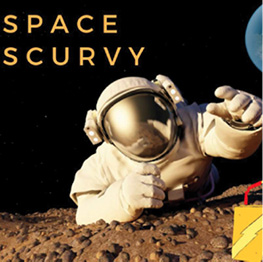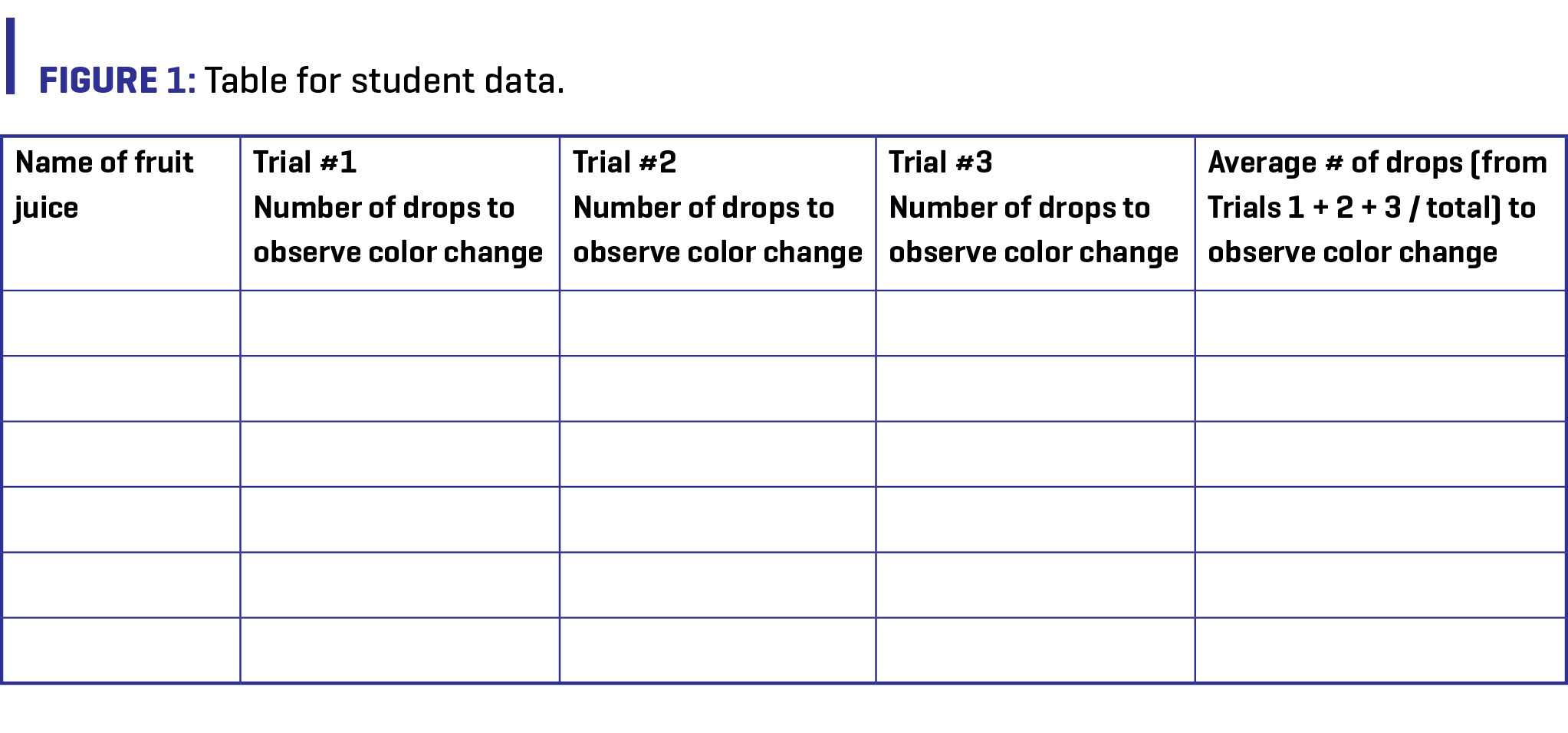citizen science
Keep Space Scurvy Away With Ascorbic Acid a Day
Science Scope—January/February 2021 (Volume 44, Issue 3)
By Jill Nugent

In the 16th century, symptoms such as the swelling of gums and loss of teeth were observed and described by pirates and sailors who were away at sea for extended periods of time. Roughly 200 years later, the British Royal Navy noted that the consumption of fruits such as oranges and lemons appeared to resolve the symptoms. Today we know that scurvy is the condition associated with the symptoms observed at sea centuries ago; the cause of scurvy is a vitamin C deficiency. Vitamin C, also known as ascorbic acid, is a water-soluble vitamin that humans must consume in their diet as it cannot be stored in the human body. Citrus fruits and green vegetables serve as sources of vitamin C. After two to three months without adequate dietary intake of vitamin C, the symptoms described by pirates and sailors will occur. Although we know the cause of scurvy and the importance of vitamin C in the human diet, scurvy is still occasionally seen in modern times, whenever vitamin C is not being consumed.
Space Scurvy is a global citizen science project that invites learners to investigate the vitamin C content of fruit juices. Students engage in hands-on research and are asked to identify the juice with the highest amount of vitamin C. Students then recommend selected juices to take to space, ensuring that 21st-century explorers have sufficient vitamin C on hand to prevent scurvy. The project prompt is inviting; it reads:
Congratulations! You and your class have been selected to go into space! . . . you will need to take some . . . juice . . . which ones do you take? Should you take fresh juice? Which has the most Vitamin C and can protect you against the dreaded Space Scurvy?
Space Scurvy provides opportunities to implement effective science learning strategies to reach all learners in the classroom, including project-based learning; conducting a hands-on investigation; engaging in group collaboration; and doing citizen science as a way to understand and learn more about the physical, natural world around us.
Project goal: To survey vitamin C content found in assorted fruit juices around the world
Your task: Using household items, determine the vitamin C (ascorbic acid) content of fruit juice
Science discipline: Physical Science (chemistry) and Life Science
In the activity, students will be testing for the presence and amount of vitamin C in juice. Students can work in groups, with each student being assigned a task. If learners are remote or distributed, they can collaborate synchronously and asynchronously using technology while serving in their designated roles; these roles might include background researchers, hands-on investigators or demonstrators, data recorders, and results writers. The activity involves noting color changes, so any students that may have sight limitations or are color blind can be placed in a collaborative group that will assist in describing the number of drops needed to detect a color change. Iodine is a part of this activity, so teachers may choose to demonstrate the activity (in the classroom, in a
recorded video, or in a live online session) and have the students focus on recording observations and synthesizing results if iodine use is a concern. Iodine can easily stain, and proper handling in accordance with the iodine’s safety data sheet (SDS) and the school’s Chemical Hygiene Plan must be followed.
Prior to the student investigation, two solutions need to be prepared—Solution A and Solution B. Solution A is the starch indicator, and preparing it involves stirring a teaspoon of starch in hot water. Solution B is the ascorbic acid liquid consisting of a crushed ascorbic acid tablet in water. If any juice contains pulp (such as some orange and grapefruit juices do), strain the juice first with the cloth/towel and funnel listed in the materials. The Space Scurvy website provides a step-by-step procedure for participants to follow (see “Project home”). It may be helpful to do a teacher-led demonstration of the overall procedure using one juice prior to student testing of additional juices.
Materials you will need:
- assorted fruit juices
- 200 ml of hot water
- cold tap water
- 1 crushed vitamin C tablet of known ascorbic acid amount (make note of amount on packaging, such as 250 mg per tablet)
- 1 teaspoon or similar 5 ml measuring spoon
- 1 measuring cup (250 ml,
- 500 ml, or 1 L)
- eye droppers
- clear plastic cups
- paper towel or kitchen cloth (only needed if juice has pulp; towel/cloth is used to strain pulp)
- funnel
- starch (such as corn starch)
- poviodine-iodine solution (such as Betadine, Isodine, PVP Iodine; 500 ml will suffice for the whole class)
- permanent marker to label solutions
- pencil and paper to record data
- calculator (optional)
Students will count the number of iodine solution drops needed until they note a color change (see “Project home”). The fewer the drops for the color change, the less vitamin C concentration the fruit juice contains. To help with the reliability and validity of results, students are asked to conduct three trials for each juice and then calculate an average for each juice. Students can record data in their notebook (see Table 1).

Table for student data.
After conducting the investigation, students can discuss the following:
- Which juice had the most vitamin C of the juices that were tested?
- Based on your test results, which juice would you choose to take into space?
- How did your test results compare with the juice container information regarding vitamin C content?
- Are there any factors that may impact the amount of vitamin C in juices (such as storage conditions)?
- After investigating the vitamin C content in various juices, are there juices that you would no longer want to drink?
- What further questions do you have? What additional questions would you like to investigate?
Each student group can report their results and further questions and share with the class. Students may wonder about space conditions, especially variables associated with space travel
and nutritional needs; in fact, NASA is researching this area as well (see “NASA Research” in “Additional Resources”). Two additional related resources (see “Measuring the Vitamin C in Food” and “Science Buddies”) contain materials related to the Space Scurvy investigation and serve to supplement “out of this world” science!
Space Scurvy at a glance
When: Anytime
How: Visit the project website (see “Project home”) and gather the materials needed. After following the procedure outlined on the website, record and report your results to the project website, or through the project’s mobile app, available on iOS and Android.
Where: Global
Time needed: 30–45 minutes
Special equipment needed: See “Project home” for a list of materials needed.
Cost: No cost to participate; the materials needed will cost under $50 USD in total, and many items may already be found around the home and/or present in the school science lab.
Contact for more information: Direct message the project owner from the project home.
Safety: As with any science lab, classroom, or field activity, always ensure that you are following recommended safety practices; for more information on safety in the science classroom visit www.nsta.org/safety.
HELPFUL PROJECT LINKS
Project home—https://www.anecdata.org/projects/view/588
Project link on SciStarter—https://scistarter.org/space-scurvy
ADDITIONAL RESOURCES
Measuring the Vitamin C in Food—http://www.rsc.org/learn-chemistry/collections/experimentation/collaborative-chemistry/chemistry-week-2013
NASA Research—https://www.nasa.gov/content/an-orange-a-day-keeps-scurvy-away/
Science Buddies: Vitamin C in Orange Juice—https://www.sciencebuddies.org/science-fair-projects/project-ideas/Chem_p044/chemistry/which-orange-juice-has-the-most-vitamin-c
Jill Nugent (jillfnugent@gmail.com) teaches science online, engages educators in citizen science experiences for the classroom, schoolyard, and beyond, and serves on the SciStarter Team. Follow SciStarter on Twitter: @SciStarter.
This column is the result of a partnership between SciStarter and the National Science Teaching Association. For more information about SciStarter and other citizen science projects, please visit www.scistarter.org.
Astronomy Citizen Science Physical Science Middle School


